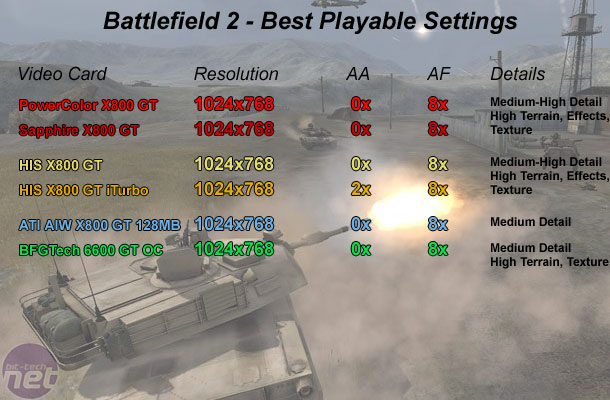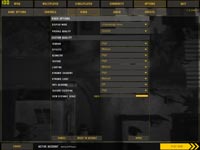
How We Tested:
Please be aware that the way we test our video cards is not a like-for-like comparison, and it is not meant to be. We decided to concentrate on finding the "Best Playable" settings - this means that we're finding the best possible gaming experience delivered on each different configuration. There are no time demos used in our evaluations - we're focusing on the real-world gaming experience, which is, ultimately what should determine your next graphics card's purchase.In the light of some recent feedback from our forum members, we have decided to change the way that we display our results. Rather than focusing on reporting the minimum and average frame rates for every configuration, we have decided to move the focus to resolution and settings. Thus, we are displaying our "Best Playable" resolutions and settings in a table that should be easier to understand than our previous implementation. If you take the logic that the higher the resolution and in game details, the faster the video card, you will not go far wrong.
In situations where we find that two competing video cards run at the same settings, we will bring the frame rates in to the discussion of our game play experiences with each particular video card.
System Setup
AMD Athlon 64 FX-57 (operating at 2000MHz, 10x200 - ~Athlon 64 3400/3500+); DFI LANPARTY nF4 SLI-DR (NVIDIA NForce4 SLI); 2 x 512MB OCZ PC5000 Platinum Series (operating in dual channel with 2.0-2-2-10 timings); Western Digital 200GB Caviar SATA 150 Hard disk drive; OCZ PowerStream 520W Power Supply; Windows XP Professional Service Pack 2; DirectX 9.0c; NVIDIA NForce4 Standalone chipset drivers, version 6.53.Video Cards:
- 1 x PowerColor GameFX X800 GT 256MB - operating at its default clock speeds of 473/986MHz using Catalyst 5.8 WHQL with Catalyst Control Center.
- 1 x HIS Radeon X800 GT IceQ II iTurbo 256MB - operating at both its default and enhanced clock speeds of 475/980MHz and 500/1000MHz using Catalyst 5.8 WHQL with Catalyst Control Center.
- 1 x Sapphire Hybrid Radeon X800 GT 256MB - operating at its default clock speeds of 473/986MHz using Catalyst 5.8 WHQL with Catalyst Control Center.
- 1 x ATI All-In-Wonder X800 GT 128MB - operating at its default clock speeds of 393/995MHz using Catalyst 5.8 WHQL with Catalyst Control Center.
- 1 x BFGTech GeForce 6600 GT OC - operating at clock speeds of 525/1050MHz in SLI mode using Forceware version 77.76.
_____________________________
Battlefield 2
Publisher: Electronic ArtsWe are using the follow up to Battlefield 1942 and Battlefield: Vietnam, Battlefield 2. It features an all-new game engine based on the DirectX 9.0 API. There is no Shader Model 3.0 support, but the majority of hardware will use a Shader Model 2.0++ mode that includes support for Normal Maps, Parallax Mapping, Full-Resolution Dynamic Shadowing, Post Processing and Fog.
The game will look the same on both NVIDIA and ATI hardware, so there is no advantage of choosing one over the other in image quality related circumstances. The only major difference is that Ultra Shadow 2 is utilised on NVIDIA's hardware, while the Shadowing on ATI hardware is done using a slightly different technique.
We played five five-minute segments of the same map, taking the median frame rate as our published frame rates. We found that there was no 100% repeatable way to benchmark this game manually, so we felt that taking a typical slice of action from the game was the best way to report our findings. We controlled Anti-Aliasing from inside the game, while Anisotropic Filtering was set to 8xAF when the 'Texture Filtering' option was set to 'High'.
Below is a table of the best-playable settings that we found best for each video card configuration. In this title, we found that 25 to 30 frames per second minimum and a target of 65 frames per second (or higher) for the average frame rate delivered a smooth and fluid gaming experience.

When we increased the HIS X800 GT's clock speeds with iTurbo mode, we found that we were able to apply 2xAA as well, meaning that the game looked a hell of a lot nicer than without any Anti-Aliasing. Battlefield 2 can suffer from some harsh aliasing at lower resolutions, so being able to apply 2xAA is a bonus for the HIS X800 GT IceQ II iTurbo.
The All-In-Wonder X800 GT's 128-bit memory interface and lower core clock speed meant that we had to reduce all details except Texture Filtering down to Medium quality in order to attain a smooth gaming experience in this title. We feel that the lack of memory bandwidth is the main problem here.
Finally, the BFGTech 6600 GT OC was slower than the Radeon X800 GT's at their stock clock speeds - we found that the BFGTech's best-playable settings in this title were 1024x768 0xAA 8xAF with Medium detail. However, there were a couple of details we were able to set to High - those were Terrain and Texture, and of course Texture Filtering in order to apply 8xAF to the scene.

MSI MPG Velox 100R Chassis Review
October 14 2021 | 15:04







Want to comment? Please log in.